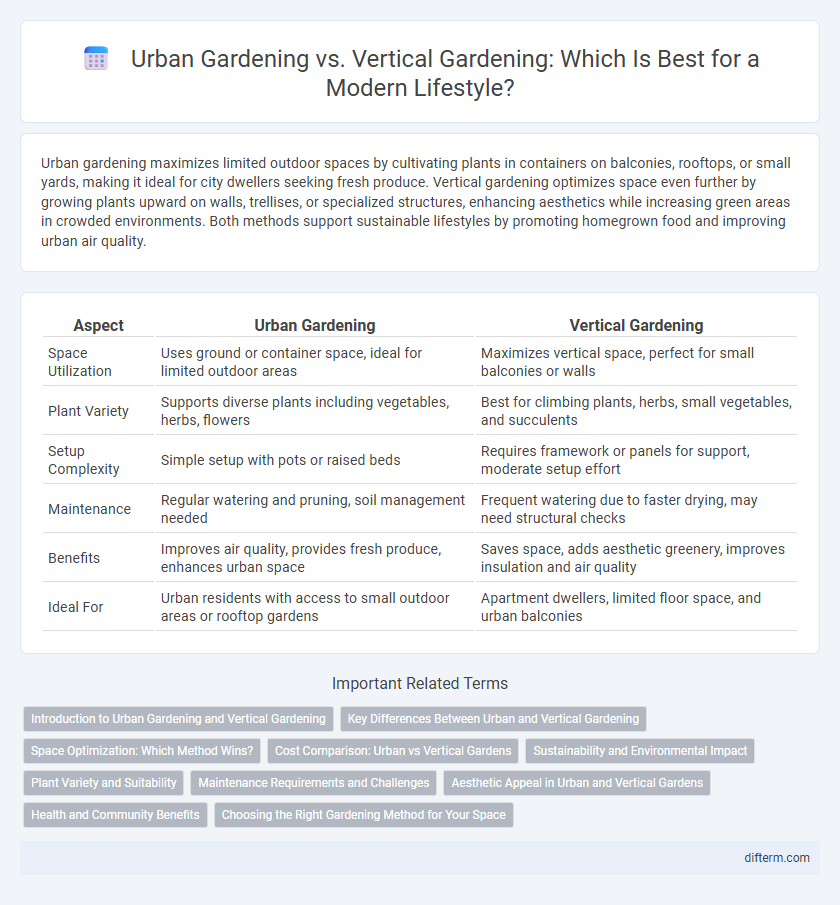Urban gardening maximizes limited outdoor spaces by cultivating plants in containers on balconies, rooftops, or small yards, making it ideal for city dwellers seeking fresh produce. Vertical gardening optimizes space even further by growing plants upward on walls, trellises, or specialized structures, enhancing aesthetics while increasing green areas in crowded environments. Both methods support sustainable lifestyles by promoting homegrown food and improving urban air quality.
Table of Comparison
| Aspect | Urban Gardening | Vertical Gardening |
|---|---|---|
| Space Utilization | Uses ground or container space, ideal for limited outdoor areas | Maximizes vertical space, perfect for small balconies or walls |
| Plant Variety | Supports diverse plants including vegetables, herbs, flowers | Best for climbing plants, herbs, small vegetables, and succulents |
| Setup Complexity | Simple setup with pots or raised beds | Requires framework or panels for support, moderate setup effort |
| Maintenance | Regular watering and pruning, soil management needed | Frequent watering due to faster drying, may need structural checks |
| Benefits | Improves air quality, provides fresh produce, enhances urban space | Saves space, adds aesthetic greenery, improves insulation and air quality |
| Ideal For | Urban residents with access to small outdoor areas or rooftop gardens | Apartment dwellers, limited floor space, and urban balconies |
Introduction to Urban Gardening and Vertical Gardening
Urban gardening transforms small city spaces into productive green areas by utilizing balconies, rooftops, and community plots to grow vegetables, herbs, and flowers. Vertical gardening maximizes limited space with structures such as wall-mounted planters, trellises, and hydroponic systems that allow plants to grow upward rather than outward. Both methods enhance urban sustainability, improve air quality, and provide fresh produce, catering to the increasing demand for local, organic food in dense urban environments.
Key Differences Between Urban and Vertical Gardening
Urban gardening involves cultivating plants in small outdoor spaces like rooftops, balconies, or community plots, emphasizing maximizing green areas within city environments. Vertical gardening focuses on growing plants upwards using structures such as trellises, walls, or stacked containers to optimize limited horizontal space and enhance aesthetic appeal. Key differences lie in spatial orientation, plant arrangement, and suitability for dense urban settings where vertical gardens save ground space while urban gardens often require more surface area.
Space Optimization: Which Method Wins?
Urban gardening maximizes limited ground space by utilizing small plots and containers, making it ideal for balconies and rooftops. Vertical gardening optimizes vertical surfaces with wall-mounted planters and trellises, significantly increasing planting area in tight urban environments. When comparing space optimization, vertical gardening often wins by transforming unused vertical walls into productive green spaces.
Cost Comparison: Urban vs Vertical Gardens
Urban gardening typically involves higher initial costs due to land preparation and traditional soil-based planting, while vertical gardening requires investment in specialized structures and irrigation systems but saves space and reduces soil usage. Maintenance expenses for urban gardens can vary with scale and crop choice, whereas vertical gardens often benefit from automated watering solutions that lower long-term labor costs. Choosing between urban and vertical gardening depends on budget constraints, available space, and desired crop output efficiency.
Sustainability and Environmental Impact
Urban gardening reduces carbon footprints by utilizing local green spaces, promoting biodiversity, and improving air quality in densely populated areas. Vertical gardening maximizes limited space through high-efficiency plant arrangements, conserving water and reducing land use, which enhances sustainability in urban environments. Both methods contribute significantly to environmental health by lowering urban heat islands and supporting sustainable food production.
Plant Variety and Suitability
Urban gardening offers a wide variety of plants, including fruits, vegetables, and herbs, suitable for small outdoor spaces like balconies and rooftops. Vertical gardening maximizes limited space by supporting climbing plants, compact vegetables, and hardy herbs ideal for walls or vertical structures. Both methods cater to different plant needs and spatial constraints, enhancing green living in urban environments.
Maintenance Requirements and Challenges
Urban gardening demands regular soil management, pest control, and adequate sunlight, often limited by space constraints in city environments. Vertical gardening reduces ground space usage by growing plants on walls or structures but requires consistent irrigation systems and specialized support to prevent plant damage. Both methods face challenges in balancing plant health with urban environmental factors like pollution and fluctuating temperatures.
Aesthetic Appeal in Urban and Vertical Gardens
Urban gardening enhances aesthetic appeal by incorporating diverse plant arrangements and natural elements across limited ground space, creating vibrant green oases in metropolitan areas. Vertical gardening maximizes visual impact through layered, space-saving plant displays that transform blank walls into living art, adding texture and color in compact environments. Both methods elevate urban spaces by integrating nature seamlessly into everyday life, boosting mental well-being and property values.
Health and Community Benefits
Urban gardening improves mental health by reducing stress and increasing physical activity through cultivating green spaces in city environments. Vertical gardening maximizes limited space, enhancing air quality and promoting healthier indoor environments while fostering community interaction through shared green walls and rooftop gardens. Both practices encourage social cohesion, provide access to fresh produce, and support sustainable living within urban neighborhoods.
Choosing the Right Gardening Method for Your Space
Urban gardening maximizes small outdoor areas by cultivating plants in containers, raised beds, or community plots, ideal for limited horizontal space. Vertical gardening utilizes walls, trellises, or stacked structures to grow plants upwards, optimizing minimal footprints and enhancing air circulation. Selecting the right method depends on available space, light exposure, and plant types suited for either ground-level or vertical growth, ensuring efficient use of urban environments.
Urban Gardening vs Vertical Gardening Infographic

 difterm.com
difterm.com